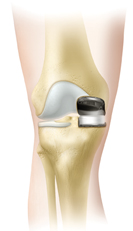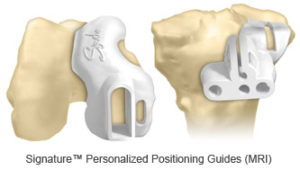 The Oxford® Partial Knee implant from Biomet Orthopedics is a partial knee implant designed to repair only one side of the knee (the medial side), making it much smaller than a total knee implant.
The Oxford® Partial Knee implant from Biomet Orthopedics is a partial knee implant designed to repair only one side of the knee (the medial side), making it much smaller than a total knee implant.
In patients with only limited knee arthritis, known as medial compartment arthritis, surgeons may elect to perform a partial knee replacement. Some advantages of the Oxford® partial knee replacement are that it removes 75% less bone and cartilage, is less painful, enables a more rapid recovery, and provides more natural motion when compared to a total knee replacement.1-3
By retaining all of the undamaged parts, the joint may bend and function more naturally.
Knee osteoarthritis usually occurs first in the medial (inside) portion of the joint. In knees that are otherwise healthy, a partial knee implant procedure can preserve the healthy bone, cartilage, and ligaments, potentially preventing or delaying the need for total knee replacement.
More Natural Motion
 In a healthy knee, the meniscus serves as a shock absorber between the ends of the bones. The Oxford® Partial Knee is the first partial implant with an artificial meniscal bearing designed to glide freely throughout the knee’s range of motion, more closely replicating normal movement. The free-floating nature of the device potentially provides for a more natural feeling knee.
In a healthy knee, the meniscus serves as a shock absorber between the ends of the bones. The Oxford® Partial Knee is the first partial implant with an artificial meniscal bearing designed to glide freely throughout the knee’s range of motion, more closely replicating normal movement. The free-floating nature of the device potentially provides for a more natural feeling knee.
New research reports that Oxford® Partial Knee patients are more likely than total knee patients to be satisfied with their ability to perform activities of daily living and report that their knee replacement “felt normal.”
Patients receiving the Oxford® Partial Knee at a minimum of one-year post-operation were:
- 1.81 times more likely than total knee replacement recipients to report that their knee felt normal.*
- 2.69 times more likely to be satisfied with their ability to perform activities of daily living.*
*Adjusted odds ratio-controlled for gender, age, minority, income, and center.
The multi-center study was led by researchers at Washington University in St. Louis, Missouri. Patients included in the study were treated with either total knee replacement, fixed-bearing unicompartmental knee replacement, or the Oxford® Partial Knee.
Centers contributing data on both total knee and partial knee replacement were Washington University, St. Louis, Missouri; Rush University Medical Center, Chicago, Illinois; and Mt. Carmel Hospital, New Albany, Ohio. Data for the study were gathered through comprehensive interviews, conducted by the University of Wisconsin, of 1,263 consecutively identified arthroplasty patients who met the inclusion/exclusion criteria. This is a Biomet-funded study and data is on file.
Long-term Durability
The Oxford® Partial Knee is the most widely used and clinically proven partial knee in the world.*6 Published long-term clinical results on the Oxford® Partial Knee demonstrated a 92.4% survivorship at 10 years,*8-14 94.0% at 15 years,*11,13-14 and 91% at 20 years.*11
There is no guarantee that any implant will successfully function for a specific length of time, as there are a multitude of variables that affect the life of an implant.
Not all patients are candidates for Oxford® partial knee replacement. You should discuss your condition and treatment options with your surgeon. Biomet offers the broadest range of partial knee replacements available, providing your surgeon with unparalleled flexibility to address your condition. All provide the option of minimally invasive surgery.
The Signature™ System
 You are unique. So when a part of you becomes affected by arthritis, you want a solution that’s just for you. That’s why Biomet offers Signature™ Personalized Patient Care*, utilizing MRI (magnetic resonance imaging) technology to create personalized positioning guides for Oxford® partial knee replacement. Using MRI technology and patient-matched guides, the Signature™ system allows for personalized instrumentation for positioning of the Oxford® partial knee.
You are unique. So when a part of you becomes affected by arthritis, you want a solution that’s just for you. That’s why Biomet offers Signature™ Personalized Patient Care*, utilizing MRI (magnetic resonance imaging) technology to create personalized positioning guides for Oxford® partial knee replacement. Using MRI technology and patient-matched guides, the Signature™ system allows for personalized instrumentation for positioning of the Oxford® partial knee.
The Signature™ system features custom femoral (thighbone) and tibial (shinbone) positioning guides made to fit directly onto your unique anatomy. The Signature™ guides are developed from an MRI scan. The MRI is used in conjunction with computer software to create a three-dimensional image of your unique joint. This enables surgeons to plan Oxford® partial knee replacement before surgery. Most surgeons typically plan surgery using two-dimensional X-rays.
Using MRI and Signature™ personalized positioning guides, surgeons have access to enhanced detail and precision for implant position and alignment before surgery. This allows for personalized instrumentation for the positioning of the implant and may help enhance surgical efficiency.
If you have questions regarding the Oxford® Partial Knee, please speak with an orthopedic surgeon or search for an Oxford® Knee trained surgeon in your area.
NOTICE:
Not all patients are candidates for partial knee replacement. Only your orthopedic surgeon can tell you if you’re a candidate for joint replacement surgery, and if so, which implant is right for your specific needs. You should discuss your condition and treatment options with your surgeon. The Oxford® Partial Knee is intended for use in individuals with osteoarthritis or avascular necrosis limited to the medial compartment of the knee and is intended to be implanted with bone cement. The Oxford® Knee is not indicated for use in the lateral compartment. Potential risks include, but are not limited to, loosening, dislocation, fracture, wear, and infection, any of which can require additional surgery. For additional information on the Oxford® knee, including risks and warnings, talk to your surgeon and see the full patient risk information on Biomet.com.